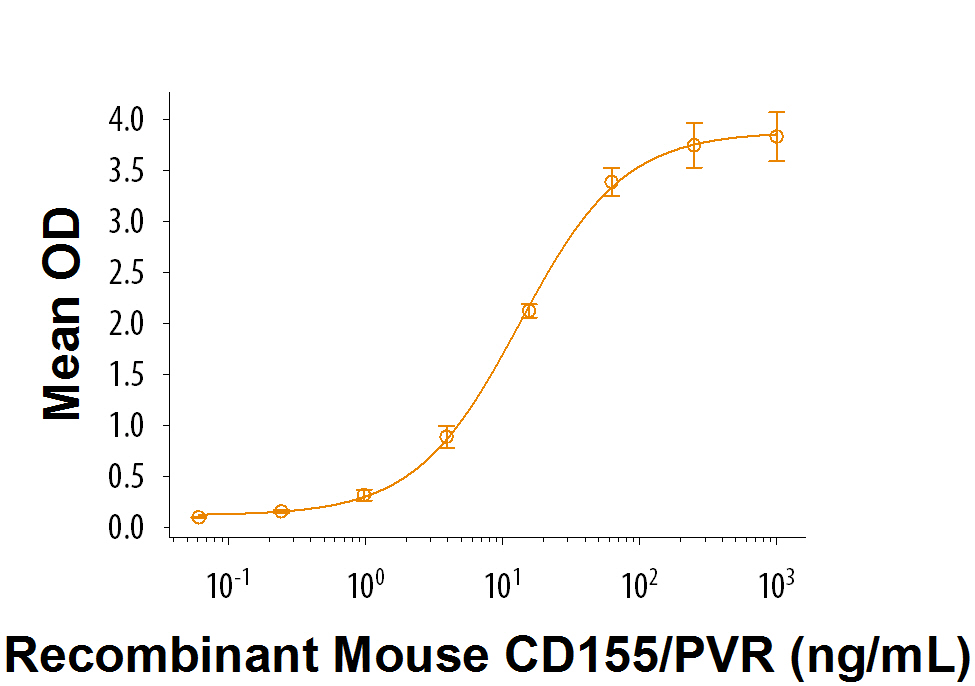Recombinant Mouse CD155/PVR Fc Chimera Protein, CF Summary
Product Specifications
| Mouse CD155/PVR (Asp29-Leu348) Accession # NP_081790 | IEGRMDP | Mouse IgG2a (Glu98-Lys330) |
| N-terminus | C-terminus | |
Analysis
Product Datasheets
Carrier Free
CF stands for Carrier Free (CF). We typically add Bovine Serum Albumin (BSA) as a carrier protein to our recombinant proteins. Adding a carrier protein enhances protein stability, increases shelf-life, and allows the recombinant protein to be stored at a more dilute concentration. The carrier free version does not contain BSA.
In general, we advise purchasing the recombinant protein with BSA for use in cell or tissue culture, or as an ELISA standard. In contrast, the carrier free protein is recommended for applications, in which the presence of BSA could interfere.
9670-CD
| Formulation | Lyophilized from a 0.2 μm filtered solution in PBS. |
| Reconstitution | Reconstitute at 500 μg/mL in PBS. |
| Shipping | The product is shipped at ambient temperature. Upon receipt, store it immediately at the temperature recommended below. |
| Stability & Storage: | Use a manual defrost freezer and avoid repeated freeze-thaw cycles.
|
Scientific Data
 View Larger
View Larger
When Recombinant Mouse CD96 (Catalog # 5690-CD) is coated at 1 µg/mL, 100 µL/well, Recombinant Mouse CD155/PVR Fc Chimera (Catalog # 9670-CD) binds with an ED50 of 6-36 ng/mL.
Reconstitution Calculator
Background: CD155/PVR
CD155, also known as PVR (poliovirus receptor), Necl-5 (nectin-like molecule-5) and, in rodents, TAGE4 (tumor-associated glycoprotein E4), is a 70-kDa type I transmembrane glycoprotein in the nectin-related family of adhesion proteins within the immunoglobulin superfamily (1, 2). CD155, which may play a role in cancer cell invasion and migration, binds other molecules including Vitronectin, Nectin-3, DNAM-1/CD226, CD96, and TIGIT but does not bind homotypically (3, 4). Mature mouse CD155 consists of a 318 amino acid (aa) extracellular domain (ECD) with one N-terminal V-type and two C2-type Ig-like domains, a 24 aa transmembrane segment, and a 38 aa cytoplasmic tail. Within the ECD, mouse CD155 shares 46%, 73%, and 44% aa sequence identity with human CD155, rat CD155, and mouse Nectin-2, respectively. The V-type domain of CD155 mediates all binding, including to polio virus (1), and alternative splicing within this domain in humans can modulate ligand binding (5). CD155 is up-regulated on endothelial cells by IFN-gamma and is highly expressed on immature thymocytes, lymph node dendritic cells, and tumor cells of epithelial and neuronal origin (1, 2, 6-9). It is preferentially expressed on Th17 cells compared to Th2 cells (10), and its activation promotes the development of Th1 responses (11). Enhanced CD155 expression in tumor cells contributes to loss of contact inhibition and increased migration but also allows tumor cell recognition and killing by DNAM-1 or CD96 expressing NK cells (1, 7, 12). Binding of monocyte DNAM-1 to endothelial cell CD155 promotes transendothelial migration (8). The expression of CD155 on mouse CD8+ thymocytes prevents their premature exit from the thymus (13). Within intestinal Peyer's patches, follicular dendritic cell CD155 activates follicular helper T cells via DNAM-1 or CD96 binding (7-9, 14). CD155 also binds the inhibitory ligand TIGIT on NK and some mature T cells, antagonizing DNAM-1 effects (7, 14, 15).
- Mandai, K. et al. (2015) Curr. Top. Dev. Biol. 112:197.
- Ravens, I. et al. (2003) Biochem. Biophys. Res. Commun. 312:1364.
- Sloan, K. et al. (2004) BMC Cancer. 4: 73.
- Sato, T. et al. (2004) Genes to Cells 9:791.
- Meyer, D. et al. (2009) J. Biol. Chem. 284:2235.
- Escalante, N.K. et al. (2011) Arterioscler. Thromb. Vasc. Biol. 31:1177.
- Xu, Z. and B. Jin (2010) Cell. Mol. Immunol. 7:11.
- Reymond, N. et al. (2004) J. Exp. Med. 199:1331.
- Maier, M.K. et al. (2007) Eur. J. Immunol. 37 :2214.
- Lozano, E. et al. (2013) J. Immunol. 191:3673.
- Yamashita-Kanemaru, Y. et al. (2015) J. Immunol. 194:5644.
- Chan, C.J. et al. (2010) J. Immunol. 184:902.
- Qui, Q. et al. (2010) J. Immunol. 184:1681.
- Seth, S. et al. (2009) Eur. J. Immunol. 39:3160.
- Stanietsky, N. et al. (2009) Proc. Natl. Acad. Sci. USA 106:17858.
Citation for Recombinant Mouse CD155/PVR Fc Chimera Protein, CF
R&D Systems personnel manually curate a database that contains references using R&D Systems products. The data collected includes not only links to publications in PubMed, but also provides information about sample types, species, and experimental conditions.
1 Citation: Showing 1 - 1
-
Blocking TIGIT/CD155 signalling reverses CD8+ T cell exhaustion and enhances the antitumor activity in cervical cancer
Authors: L Liu, A Wang, X Liu, S Han, Y Sun, J Zhang, L Guo, Y Zhang
Oncogene, 2022-06-21;20(1):280.
Species: Mouse
Sample Types: Whole Cells
Applications: Bioassay
FAQs
No product specific FAQs exist for this product, however you may
View all Proteins and Enzyme FAQsReviews for Recombinant Mouse CD155/PVR Fc Chimera Protein, CF
There are currently no reviews for this product. Be the first to review Recombinant Mouse CD155/PVR Fc Chimera Protein, CF and earn rewards!
Have you used Recombinant Mouse CD155/PVR Fc Chimera Protein, CF?
Submit a review and receive an Amazon gift card.
$25/€18/£15/$25CAN/¥75 Yuan/¥2500 Yen for a review with an image
$10/€7/£6/$10 CAD/¥70 Yuan/¥1110 Yen for a review without an image
